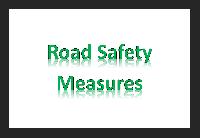
With the surging economy, vehicle population expanded in the country during the last one decade. Though road networks also improved, mounting pressure on roads from expanded vehicle population has aggravated safety issues. Credible data about road accidents are not available, still, preliminary reports indicate that Indian roads are witnessing higher incidence of accidents. As per the Supreme Court appointed Committee on road safety, nearly 150000 people die in road accidents in the country every year. Another 5 to 7 lakh people are believed to be injured, leading to handicapped status. Government has made several efforts to enhance road safety in recent years. A major one was the appointment of the Committee on Road Transport and Traffic Management (Sundar Committee, 2007). Following are the important steps taken in recent years to enhance road safety in the country.
1. A multi-pronged strategy has been adopted by the Ministry of Road Transport and Highways, based on the 4 Es – Engineering, Enforcement, Education and Emergency Care for ensuring road safety. Here, better and safer road engineering, more effective legislation, improved vehicular safety standards, training of drivers, improved trauma care and generating public awareness are made.
2. Making engineering level innovations to improve road safety: The MORTH has established a Road Safety Cell (Engineering) (RSCE) in 2015 to exclusively work on Road Safety Engineering. Ministry is making concerted efforts in road safety engineering by way of:
i. Identification and rectification of road accident black spots
789 road accident black spots have been identified based on previous year
fatality data obtained from Police authorities of various states. Safety measures were launched for these spots through various steps. The MORTH has set apart Rs 11000 crores for black spot rectification.
ii. Road Safety improvement works at identified accident prone locations on NHs under Road Safety Annual Plans
Separate annual amounts (Rs. 600 crores in 2016-17) has been earmarked for sanctioning road safety engineering works including works for rectification of black spots and installation of crash barriers in hilly terrain.
iii. Road Safety Audits – Guidelines have been issued for carrying out road safety audits and NH stretches.
iv. Improving road accident data collection and data base management
v. Training of Highway Engineers and Professionals in Road Safety Engineering
vi. Improving Vehicular Safety Standards.
This is done on the basis of vehicle classes. Trucks are prohibited from carrying protruding rods; Anti-locking Brake System (ABS) made mandatory on Heavy Vehicles; Cars to have provision for fitment of at-least one child seat. Car Crash Standards to be made mandatory and induction of ABS/CBS for Two Wheelers are made mandatory from April, 2018; AHO (Automatic Headlight On) made mandatory for Two Wheelers to make them more conspicuous; Bus Body Code for safer and comfortable buses; Truck Body Code for safe cabins to drivers and other road users; Mandatory Fitment of Speed Governors on Transport Vehicles to avoid over speeding are other Vehicular Safety Standards introduced.
vii. Training of Drivers: Model Institutes of Drivers Training and Research (IDTR) and Refresher course for Drivers in the unskilled sector.
viii. Effective Trauma Care
xi. Pilot Projects for Cashless Treatment of Road Accident Victims were done on Gurgaon-Jaipur, Vadodara – Mumbai stretch of NH 8 and Ranchi-Rargaon-Mahulia stretch of NH 33. Now it is proposed to implement this scheme along the Golden Quadrilateral, North South and East West Corridors (about 13500 km) at an estimated cost of about Rs. 250 Crore.
x. Good Samaritans Guidelines – Guidelines have been issued by the Ministry to prevent the harassment of “Good Samaritans” who help road accident victims. The Supreme Court has accepted these guidelines and has asked states for implementation.
xi. Highway Advisory System (HAS)
HAS is a free-to-air information distribution system that uses radio to make the travelling National Highways safer, faster and hassle-free. Under the project real time highway information will be gathered from concessionaires, patrol vehicles, toll plazas and traffic marshals. This information will be transmitted to HAS control centre using mobile applications, telephones and sensors. HAS control centre after analyzing the data, generate alerts and send it to be broadcast by All India Radio. It was launched in March 2016 as a pilot project on Delhi-Jaipur highway.
xii. Quick response ambulances: in every 50 kms on National Highways by the NHAI.
3. Road Safety Bill: The MoRTH introduced the Motor Vehicle (Amendment) Bill 2016 in Parliament (Lok Sabha) in August, 2016. The Bill addresses several road safety issues by providing for stiffer penalties, permitting electronic enforcement, improving fitness certification and licensing regime, statutory provisions for protection of good Samaritans and recognition of IT enabled enforcement systems etc. It also advocates reforms in public transport to improve road safety. Other provisions of the bill like treatment of accident victims during golden hour etc., will help to save injured lives in road accidents. The Bill has been referred for higher references.
*********









